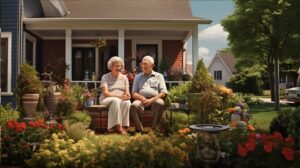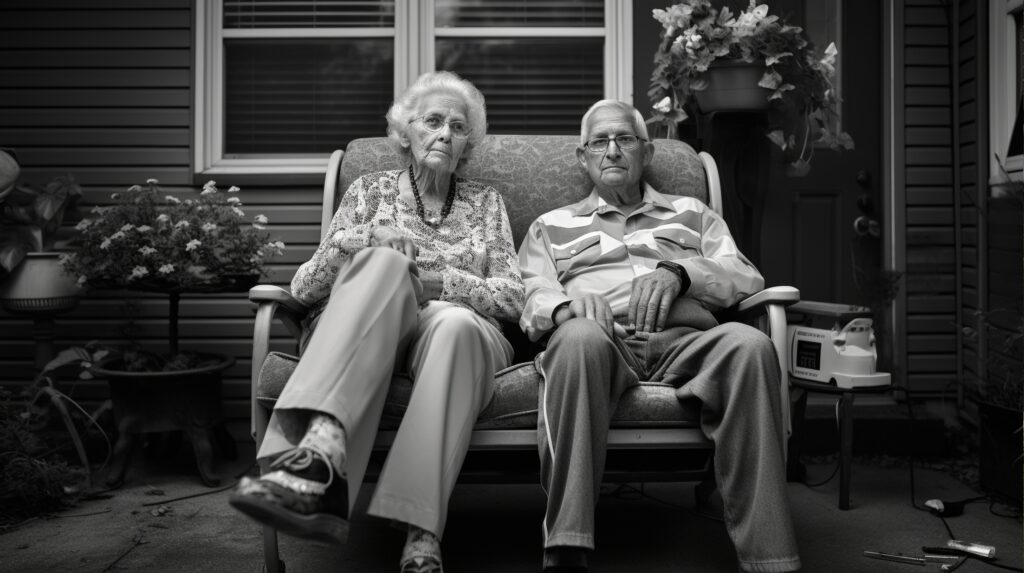In the dim corners of memory, I recall the walls of my childhood home, lined with photos of generations before me — a tapestry of time and life that seemed endless. These walls bore witness to my parents’ laughter, arguments, and silent moments of reflection. So, it was no surprise when they expressed a fervent wish: to let the later chapters of their lives unfold within those very walls, aging in a place surrounded by familiar nooks and comforting crannies.
Aging in place, as it’s so delicately termed, isn’t just about remaining in one’s home. It’s a deep-rooted desire to hold onto the essence of oneself, to the stories embedded in the floorboards and the secrets whispered to the windowpanes. At its core, it’s about choosing continuity over change, familiarity over foreignness.
As the years turned into decades, I watched my parents grow older, their movements slowing, their voices softening. Yet, their determination to age in their own sanctuary only strengthened. Their conviction made me reflect: isn’t there an innate longing in all of us to be surrounded by the familiar as we confront the mysteries of old age? Their journey and my role in it prompted questions, revelations, and more than a few sleepless nights.
Aging in Place: The Philosophical Roots of Home
In my many years of pondering the intricacies of human emotion and connection, I’ve often been drawn to a singular, profound query: Why do we, as beings of consciousness and thought, yearn so deeply for the familiar embrace of a place we call ‘home’?
been drawn to a singular, profound query: Why do we, as beings of consciousness and thought, yearn so deeply for the familiar embrace of a place we call ‘home’?
Plato once mused about the world of forms, a realm where perfect, immutable ideas reside. Could it be that our sense of ‘home’ is a shadow of that realm, a place where our imperfect memories and experiences strive to touch the ideal? This is not merely about bricks and mortar but a realm where our very soul feels anchored.
Our connection to ‘home’ isn’t merely a product of habit or routine; it’s a tapestry woven with threads of identity and memory. Philosophers have long debated the nature of self, and in my reflections, I’ve found that our homes serve as mirrors, reflecting who we were, who we are, and perhaps who we might become.
Memories aren’t just abstract thoughts; they’re entwined with the sensory experiences of our dwellings—the scent of a decades-old wooden cabinet, the sound of a creaking floor, or the touch of a well-worn banister. These sensations, embedded in our psyche, form a bridge between our past and present selves.
When the world might seem increasingly alien and unpredictable in the twilight of life, is it not natural for us to seek solace in the familiar? To find comfort in a place that has silently witnessed our joys, sorrows, victories, and defeats? In that sense, the walls of our homes are not just barriers against the elements, but keepers of our very essence.
The Psychological Benefits of Aging in Place
In my explorations of the human psyche, I’ve often marveled at our resilience and adaptability. Yet, despite our capacity to adapt, we also have a deep-seated need for constancy, especially as the sands of time slip through our fingers. Why is it that as the horizon of our lives begins to shorten, the allure of familiar surroundings becomes so potent?
From a psychological vantage point, our spaces aren’t just physical entities; they serve as an extension of our inner selves. I’ve observed, both in literature and in lived experiences, that the familiar corners of one’s dwelling can act as a balm, soothing the anxieties that often accompany the golden years. It’s not just about the physical comfort; it’s the emotional cushioning these spaces provide.
Being able to dictate the rhythm of one’s day, to decide when to sip that morning coffee or take a leisurely afternoon nap, carries with it a priceless sense of autonomy. This freedom, this independence, nourishes the soul. It provides a psychological boost, reinforcing the notion that one is still the master of one’s fate, even in the twilight of life.
And then, there are memories. Each room, each artifact, tells a story. Perhaps it’s the kitchen where countless family meals were prepared or the living room where celebrations echoed with laughter. These memories are not mere recollections; they’re anchors, grounding us, reminding us of our journey, our struggles, and our triumphs. In moments of solitude, these memories can be a source of comfort, a reminder of a life well-lived.
In essence, aging in place is not just a logistical choice. It’s a dance between the past and the present, a psychological embrace of one’s life narrative set against the backdrop of a familiar stage.
The Challenges and Realities of Aging in Place
As I navigated the intricate pathways of caregiving and delved deeper into the human psyche, it became evident that the choice to age in one’s own home, though filled with comforts, is not devoid of its trials. One might wonder: if the benefits are so profound, why isn’t the decision to age in place a straightforward one?
As the clock’s hands continue their inexorable march, the physical and mental demands on the elderly intensify. Unpredictable health crises can emerge, casting shadows of doubt and fear. Memory, once sharp and reliable, might waver, turning simple tasks into Herculean challenges. The routines that once brought solace can become daily battles, testing the limits of their resilience.
And it’s not just the elderly who bear the brunt. The ripple effects extend to those who love and care for them. I’ve seen, firsthand, the weight of responsibility that presses down on family members, pulling at the fabric of their lives. There’s a silent struggle, a balancing act between honoring the wishes of the elderly and ensuring their safety and well-being.
Caregivers, too, find themselves on this tightrope. With every visit, they carry the hopes and fears of families, striving to provide medical care and a sense of normalcy and dignity. Their role is pivotal, and yet, it’s not without its emotional toll. The lines between professional duty and personal connection often blur, making their task both rewarding and heart-wrenching.
In sum, while the idea of aging amidst familiar walls offers solace, it also presents a matrix of complexities. It’s a journey that demands adaptability, understanding, and, above all, boundless compassion.
The Dichotomy of Independence and Dependence
Throughout my journey into the human psyche, a theme has persistently surfaced, a taut thread running through the tapestry of our lives: the tug-of-war between independence and dependence. We’ve all participated in this dance, from our first breaths to our last. But what does it mean for those standing at the crossroads of aging, yearning for autonomy yet grappling with an ever-growing need for support?
I’ve realized that this dichotomy isn’t just a matter of logistics or physical capability. It’s deeply intertwined with our sense of identity. To be independent is to be in control, to be the author of one’s own story. But what happens when the body betrays the mind? When the spirit is willing, but the flesh is weak?
I’ve often pondered the philosophical implications of this cycle. We begin our lives entirely dependent, innocent, and vulnerable, seeking solace in the arms of our caregivers. As we grow, we break free, forging our path and cherishing the taste of autonomy. Yet, as the twilight years approach, there’s a poignant return to a state of reliance. It’s a humbling reflection, a full circle in the grand narrative of existence.
But there’s a profound beauty in this cycle. In our moments of dependence, we’re reminded of our shared humanity, our interconnectedness. The roles may reverse, but the bond of care and love remains unbroken. The challenge lies in reconciling our inner desires for autonomy with the external realities of aging. It’s a delicate balance, one that requires grace, understanding, and an embrace of life’s inherent uncertainties.
Final Reflections
Reflecting on my parents’ unwavering desire to grow old within the embrace of their cherished home, I’m reminded of the deeply human quest for continuity amidst change. Life’s winding journey often presents us with moments of introspection, where we grapple with the balance between the heart’s yearnings and the pragmatic realities that unfold before us.
The pull of familiarity, of echoing laughter and hushed conversations reverberating through the hallways of memory, is strong. Yet, with it comes the undeniable reality of aging – the fragility, the vulnerability, the need for an extended hand or a comforting word. It’s a juxtaposition that every family, including my own, must face: the emotional resonance of wishes against the tangible challenges of age.
I’ve come to understand that beyond the logistics and practicalities, what truly matters is the dialogue—a dialogue steeped in empathy, where aging parents can voice their desires and fears and where children, often grappling with their anxieties, can listen and be heard. It’s through this exchange, this meeting of minds and hearts, that true understanding can blossom.
To navigate this intricate dance of aging in place, I believe we must all become champions of compassion, of patience, and of open-hearted conversation. For in these dialogues, we not only find solutions but also rediscover the bonds that tie us together, transcending the constraints of time and age.
As I sit back, allowing the weight of these reflections to settle, my thoughts drift towards those unsung heroes – the caregivers and health aides. Their presence, often understated, plays an instrumental role in the tapestry of aging in place. With each gentle touch, reassuring word, and silent act of care, they become the pillars upon which many elderly individuals lean.
Yet, beyond individual acts of kindness and professionalism, we must consider a broader canvas. Society at large has a role to play. I’ve realized that if the desire to age in one’s own home is to be a viable choice for many, we must collectively strive for improved infrastructure and support mechanisms. Aging in place isn’t merely a personal decision; it’s a societal commitment.
In the grand theatre of life, where scenes shift and roles evolve, may we all remember the importance of setting the stage right, ensuring that the final acts are played out with dignity, respect, and above all, a sense of belonging.
